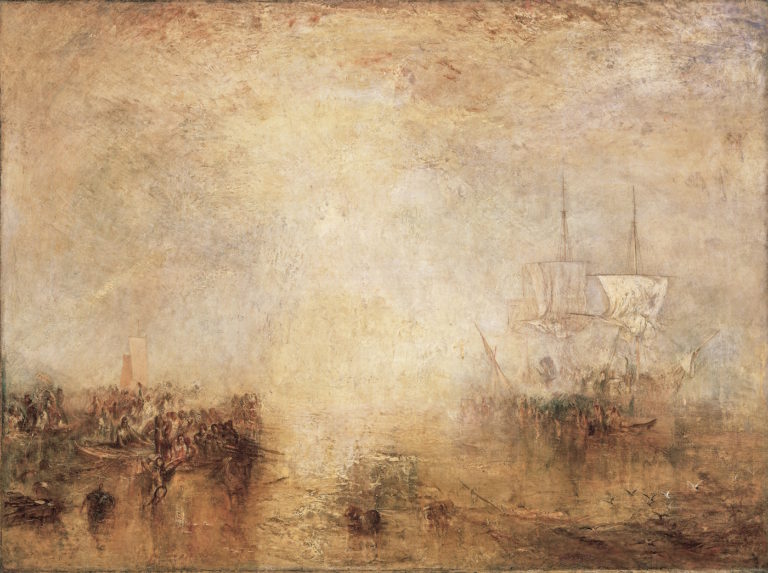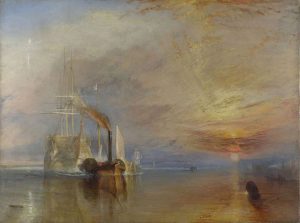
Joseph Mallord William Turner was born on 23 April 1775 at 21 Maiden Lane, Covent Garden, London, the son of William Turner (1745–1829), a barber and wig-maker, and his wife Mary, née Marshall (1739–1804).
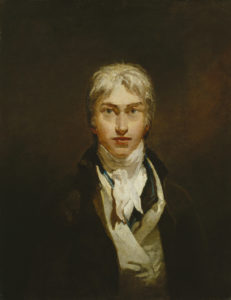
From these humble beginnings, one of the greatest artists of the early nineteenth century rose to straddle the art world of Regency England like a Colossus. From his earliest watercolors and sketches to perhaps his most lauded painting, The Fighting Temeraire, his work was admired for his incredible use of color and technique to evoke the sense of movement and realism touched by the shimmer of magic few artists before him had managed.
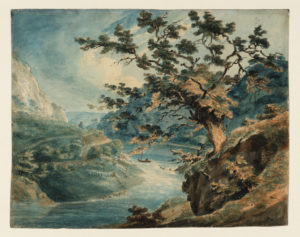
At the age of fourteen he entered the Royal Academy. In addition to his studies, he worked with architects and architectural draughtsmen and even painted scenery for the London stage. The latter probably accounted for his lifelong love of opera and the theatre. By the time he was fifteen he was funding his education selling prints and watercolors of his work. The rest, as they say, is history. Again and again he stunned and delighted the artistic world and the Royal Academy with signature works of art. And with a rather rough, sometimes caustic personality.
Turner remained a Londoner and kept a Cockney accent all his life, avoiding the veneer of social polish acquired by many artists of the time as they climbed the professional ladder. It did not matter. His work was sought out by the highest ranks of the aristocracy and the wealthiest of the nouveau riche.
By the time he reached the age of 70 it was assumed his style was established and people knew exactly what to expect from his work. Until the Royal Academy exhibition of 1845 when two of the six canvases he exhibited stunned visitors and caused quite a stir in the art community. These two paintings, both titled Whalers, would join two more paintings, Hurrah! for the Whaler Erebus! Another Fish! and Whalers (Boiling Blubber) Entangled in Flaw Ice, Endeavouring to Extricate Themselves in 1846 to form a quartet of paintings one might never attribute to Turner if one did not know they were indeed his work.
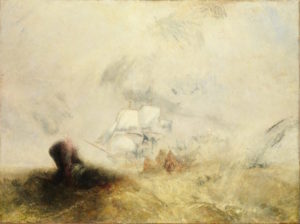
I had long been a fan of his work, what Regency romance writer isn’t, but I must confess I had neither seen nor heard of these late works. It took a trip to New York and at visit to the Metropolitan Museum of Art for me to come face to face with these amazing and forward thinking examples of Turner’s artistic talent and vision. Three of the four Whaling paintings are part of the Turner Bequest to the Tate in London. The third is part of the Wolfe Collection at the Met. Fortunately, during the time I was in New York the four paintings were reunited in an exhibit at the Met through a generous temporary loan by the Tate.
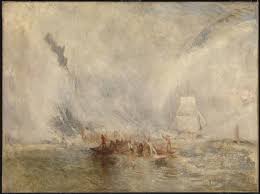
I cannot begin to explain the striking allure of these paintings simply walking into the same room with them evokes. The color palette and the motion in each of them immediately plunges the viewer into a world of feeling the ocean, the energy of the waves, the salty spray, the depth and breadth of the ships and the courage and smallness of the men. There is both mystery and clarity in each painting. The struggle between man and beast and the forces of nature come together on the canvas in a form never seen before this.
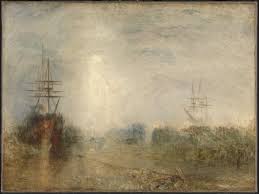
I sat for a long time before each of the paintings, studying them, and pondering the forward progression, the provocative and new ideas of an artist nearing the end of his life. Turner blazed across the artistic world of England, and as a result the world, from the humblest of beginnings to the pinnacle of artistic fame and never stopped learning, never stopped pushing the boundaries. This old artist taught the artistic world some new tricks that hinted at the world of Impressionism, but maintained always the mark of the brilliant young artist from the poor side of London.
